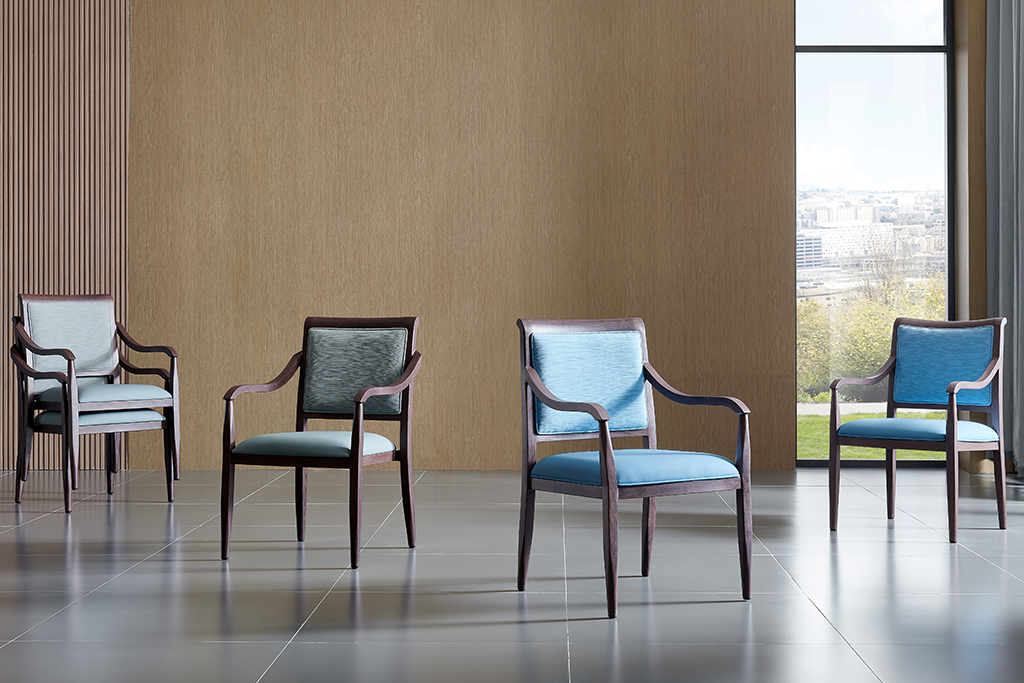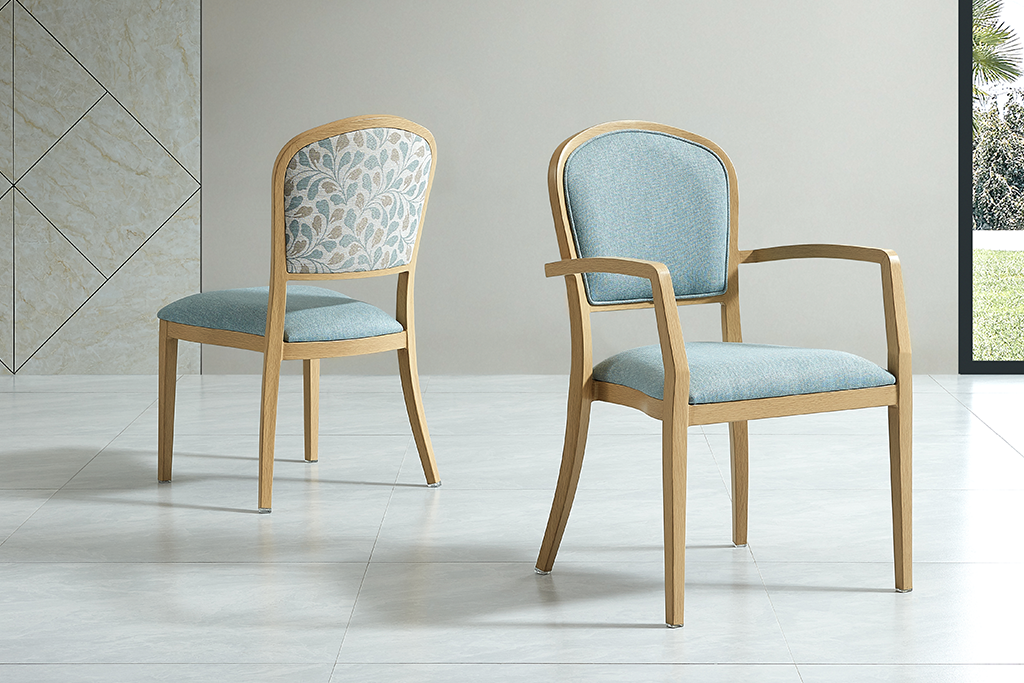How to meet the current challenges facing nursing home furniture
1. Status and Challenges of Nursing Home Furniture
In recent years, there has been a remarkable change in the design of senior living apartments, from an initial preference for institutionalized care environments to a gradual shift towards more homely atmospheres and personalized living spaces for the elderly. This change stems from a deeper understanding of the impact of the elderly's living environment on their well-being and quality of life. Today, designers are not only focusing on the physical needs of seniors, but also on their emotional needs, striving to create a comfortable and welcoming environment through design that enhances the overall living experience of seniors.
In the past, senior apartments tended to prioritize basic care needs, neglecting the comfort of the living environment, with environments leaning towards a hospital-like, cold design. However, as the lifestyles and expectations of seniors have shifted, modern senior living apartments have become more focused on comfort and family atmosphere. Today's senior living communities are designed to combine elements of luxury with a sense of coziness, making seniors feel valued and cared for. Such designs not only enhance the quality of life, but also provide residents with a greater sense of security and independence.
Modern senior living communities meet socialization needs while providing residents with quiet, private spaces through more open layouts. The introduction of natural light, the use of environmentally friendly materials and the combination of smart technologies make senior living communities more modern and functional. Especially in terms of safety and convenience, modern design provides a safer living environment for the elderly through barrier-free design and intelligent health monitoring systems.
Furniture, as an important part of a senior living community, is also being designed with constant innovation. Today's nursing home furniture should not only meet the functional needs of the elderly, but also provide a cozy visual experience and high practicality. Modern furniture helps seniors enhance their living comfort through flexible layouts, eco-friendly materials and smart technologies, and ensures the durability and safety of the furniture. For example, non-slip design flooring and easy-to-clean materials make furniture not only aesthetically pleasing, but also reduce the risk of accidents and provide greater convenience for residents.
In short, the design of nursing home furniture has gradually evolved from a single functionality in the past to a comprehensive solution that balances comfort, function and aesthetics. Through such design innovations and improvements, seniors not only enjoy a higher quality of life, but can also spend their twilight years in a safer and more caring environment.
2. Furniture design needs to meet the needs of people with dementia
Careful consideration when designing furniture for people with dementia can significantly improve their quality of life. Through the use of high contrast colors and different textures, the visibility of furniture in a space is increased, helping the person to better identify orientation and reduce feelings of disorientation and confusion. For example, a combination of dark frames and light-colored chairs can make the chairs more visible in a room, making them easier for patients to quickly find and identify.
Not only does this contrasting color help patients distinguish between different pieces of furniture, it also improves perception of depth and helps them better judge object distances. This is especially important in large public areas to help patients move smoothly through different activity areas, reducing confusion and the risk of collisions.
In addition, the use of contrasting colors for key functional areas such as armrests, chair backs, or table edges can clearly mark these important parts, helping patients better understand how to interact with the furniture and reducing misuse. This design can significantly improve patient safety, especially if they try to operate it on their own. It's also worth noting that the hidden grooves in the armrests are designed to provide additional convenience for patients, especially if they need to temporarily place their crutches. This detail not only adds functionality, but also ensures that patients can feel more confident and secure when maneuvering independently.
To further enhance comfort, haptic design is also a key element. By introducing materials with different textures, furniture can provide patients with additional tactile stimulation and enhance their sense of interaction with the environment. The use of soft, cozy materials not only helps to relax, but also increases the patient's sense of trust in the furniture.
Finally, the use of warm colors and soft materials can create a welcoming environment that helps patients feel psychologically safe and relaxed. This design concept combines sensory stimulation with emotional support, which fulfills functional needs and enhances the patient's overall sense of well-being. With properly designed furniture, people with dementia can live better and more independently and enhance their quality of life in a safe and comfortable environment.
3. Designed to accommodate a wide range of health needs
l Smooth caster design
The inclusion of casters greatly enhances the mobility of the chair. For caregivers, the smooth casters make it easy to move the chair around a room or common area without having to lift it vigorously. Made of wear-resistant materials, the casters ensure smooth gliding on different flooring materials such as wood, tile or carpet, reducing wear and tear on the floor, making it easy to push and pull the chair to quickly adjust the layout of a room or to help mobility-impaired seniors move around safely.
l Easy-grip armrests
For seniors, the armrests of a chair are not only a comfortable point of reliance, but also an important support when standing up and sitting down, helping seniors to maintain balance and reduce physical exertion when getting up. The materials used for armrests are usually carefully selected to ensure that they are both non-slip and comfortable to the touch to avoid discomfort after prolonged contact.
l The overall convenience and practicality of
This combination of smooth casters and easy-to-grip armrests not only facilitates the daily life of the elderly, but also greatly reduces the work stress of caregivers, thus improving the efficiency of caregiving. When cleaning or rearranging a room, this design greatly enhances the ease of operation.
In nursing homes and care centers, flexible furniture layouts are essential to enhancing the quality of life and socialization of seniors. Older people often spend a great deal of time in communal areas, so the proper placement of furniture not only encourages social interaction, but also ensures that those with mobility impairments are able to move around safely and freely. Proper furniture design should minimize barriers, with wide aisles to allow smooth passage of wheelchairs and mobility aids, and chairs should be arranged in groups to facilitate communication.
In addition, furniture design should be ergonomic, and chairs need to provide support and comfort, especially when used for long periods of time. At the same time, chairs should be placed close to walls or corridors to avoid blocking passageways and keep entrances and exits clear to ensure that the elderly can choose the right position according to their physical conditions.
Social connection has a profound effect on the well-being of older people. Regular social interaction not only helps with emotional support, but also improves cognitive ability and reduces loneliness. Through scientific layout and comfortable furniture design, seniors are more likely to engage in social activities, resulting in better mental and physical health.
Furniture design for nursing homes should also focus on creating a cozy atmosphere, providing a balanced environment with reasonable quiet areas in open spaces. Socialization activities not only contribute to the emotional health of the elderly, but also enhance physical function and prolong life expectancy. Therefore, the flexible design of furniture can reduce caregiving stress and enhance overall well-being while meeting the socialization needs of the elderly.
4. Selection of materials and finishes
For senior living communities, it is critical to have a proper understanding of the furniture materials needed for the healthcare environment. For example, when incontinence and food accidents can occur on a daily basis, top considerations for materials include:
The chair's seamless design and smooth, non-porous surface greatly simplifies the cleaning process. The seamless design reduces the likelihood of dirt and bacteria buildup, while the smooth surface makes liquids impenetrable and requires only standard cleaners to keep the chair sanitary. These features ensure that metal wood grain chairs remain clean in environments with high hygiene requirements.
The natural antimicrobial properties of the metal material further enhance the infection control of these chairs. Metallic materials are effective in inhibiting the growth of bacteria and viruses, making them suitable for use in locations where strict hygiene standards are required. At the same time, these chairs are adaptable to a wide range of cleaning agents and disinfectants, ensuring that they are not damaged when a variety of cleaning products are used.
High-quality aluminum or stainless steel materials are chosen for their extreme durability and resistance to damage. Whether in a high-temperature sanitizing environment or in frequent contact with liquids, these chairs maintain their integrity and are not easily damaged, making them suitable for long-term use. In addition, metal chairs can withstand frequent use, reducing the cost of replacement and maintenance.
5. Conclusion
We can fulfill all of the above product needs. The Yumeya sales team has the experience to provide personalized furniture solutions and help senior living organizations choose the most appropriate products. With our upcoming Senior Living Atlas, it will be even easier for customers to find high quality products that meet their needs. For your senior living project, whether for public spaces, private rooms, or outdoor areas, our products ensure a safe and comfortable environment for seniors and reduce the stress of caregiving.
Through the judicious use of natural elements and colors, custom seating not only improves seniors' moods, but also their overall health and well-being. This continued commitment to design and quality ensures that senior living communities are vibrant places where seniors can truly enjoy their later years.









































































































